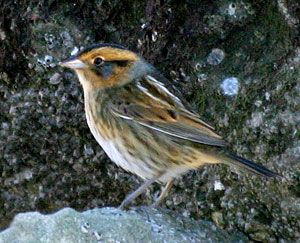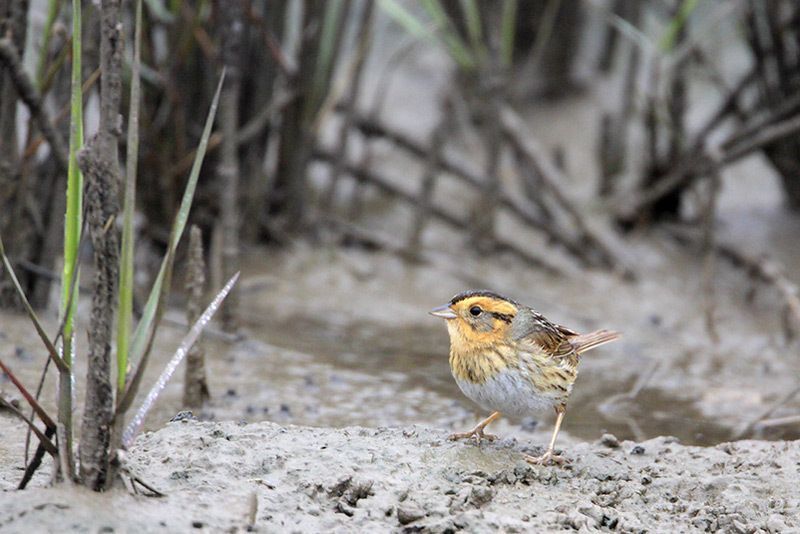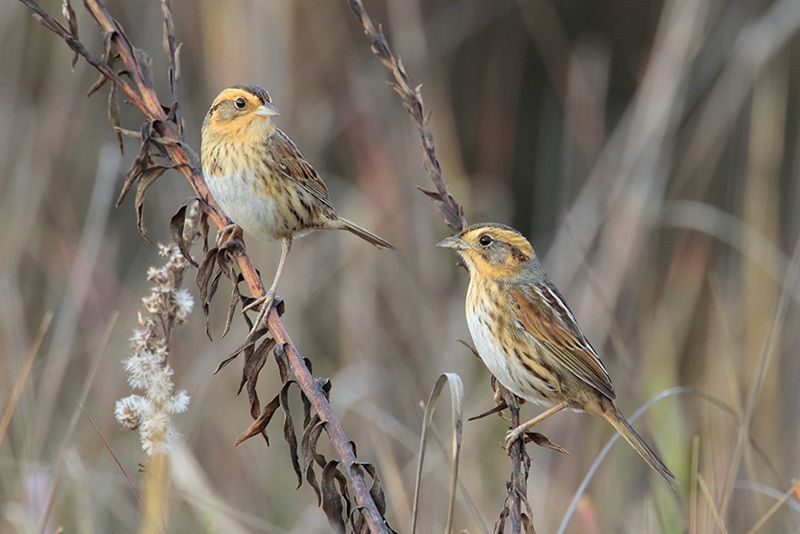Nelson's Sparrow

© Helen Baines
Ammospiza nelsoni
Family: (Passerellidae) New World Sparrows
Preferred Habitat: Saltmarshes.
Seasonal Occurrence: Common in winter; uncommon spring and fall.
Profile by Richard Gibbons: The Nelson’s Sparrow is a small, stocky songbird with an orange face, gray crown, and well defined white belly. Its neck and upper body are brown with white or gray streaks, while its breast and flanks have smudged brown streaks. Its brown tail is short and rounded with pointed tail feathers. Males are slightly larger than females, but their plumage is the same.
Nelson’s Sparrows are secretive birds which are common in coastal salt marsh habitat. They breed inland in the freshwater marshes of the northern Great Plains, in coastal marshes on the Atlantic coast from Quebec to Maine, and along the southern edges of both Hudson and James Bays. They migrate in the autumn to their wintering grounds in coastal salt marshes from New Jersey to Texas. Before they depart for the breeding grounds in Spring, their frying-pan-sizzle song can be heard emanating from coastal marshes. More adventurous birders can walk through coastal marsh grasses and hope to flush a Nelson’s Sparrow. Their weak flight and crash landing back into the grass is typical of Ammodramus sparrows.
Until 1995, the Nelson’s Sparrow and the Saltmarsh Sparrow were thought to have been the same species, the Sharp-tailed Sparrow. While Nelson’s and Saltmarsh sparrows look very similar and have an overlapping breeding range in Maine, they are distinct genetically and can be identified in the field by song.
These secretive marsh denizens spend the cooler months in Houston Audubon’s Dos Vacas Bird Sanctuary, Horseshoe Marsh Bird Sanctuary, Bolivar Flats Shorebird Sanctuary, and Mundy Marsh Bird Sanctuary.
Profile by Grace Yaros: Nelson’s Sparrows are small, colorful sparrows of wet, dense grasslands and marshes. They are white below with orange chests and sides, and their orange faces contrast with their gray cheeks. They are quite round, with short, spiky tails. LeConte’s Sparrows are similar in appearance, but can be distinguished from Nelson’s Sparrows by the white stripe running down the center of their crown (Nelson’s have a gray crown stripe). During the breeding season, males sing a relatively simple song that consists of a short, hissing trill. Males will also frequently perform flight displays during the breeding season, during which they sing a flight song that is relatively longer and more complex than their typical song.
There are three geographically distinct populations of Nelson’s Sparrows: two “Interior” forms that nest in freshwater wetlands in the Great Plains and along Hudson Bay and James Bay, and an “Atlantic” form that nests in saltwater or brackish tidal marshes along the northern Atlantic Coast in New England and Canada. All three populations spend the winter months in saltmarshes of the southeastern United States.
Loss of marsh and grassland habitat is the primary threat to these handsome sparrows. During the winter, you can find them on the Bolivar Peninsula at Bolivar Flats Shorebird Sanctuary and the 17th Street Jetty, as well as Horseshoe Marsh and along Frenchtown Road adjacent to Horseshoe Marsh.
-
Cornell Lab of Ornithology
-
Field Guide

© Greg Lavaty, www.texastargetbirds.com

© Greg Lavaty, www.texastargetbirds.com

© Greg Lavaty, www.texastargetbirds.com

© Greg Lavaty, www.texastargetbirds.com




















